There is a long history of taxonomic uncertainty about which birds belong in this family, or even if the family should be recognized. Harris & Franklin (2000), for example, seem to merge all these species into a large Bush-Shrike family [Malaconotidae]; so did Sibley & Ahlquist (1990) and Sibley & Monroe (1990), who also merged the helmet-shrikes and vangas as well. Dowsett & Dowsett-Lemaire (1993) lumps the helmet-shrikes and bush-shrikes with the world's regular shrikes in the Laniidae, but separates out the vangas, and places the wattle-eyes some distance away near the monarch-flycatchers! Sadly, it appears that the Handbook of the World series may follow that mistaken path. |
|||||
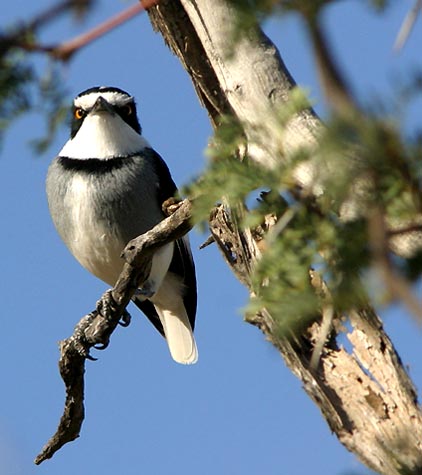
Recent biochemical work (Fuchs et al. 2004) make it clear that this family is a well-defined, monophyletic group. It does not include the shrike-flycatchers (e.g., Bias, Megabyas, Pseudobias) that are sometimes placed in the Platysteiridae (e.g., Dickinson 2003; some are actually vangas, see Cibois 1999, 2001; Schulenberg et al. 2003), but it does include the very special, and very fantastic, White-tailed Shrike (right). This Namibian endemic is engaging, personable, and unique; it is in the running for my favorite bird in the world. It is found only locally in dry scrub among rocky outcrops of northern Namibia. Detailed DNA analysis using multiple approaches confirm that the White-tailed Shrike is a member of this family (Fuchs et al. 2004, Beresford et al. 2005). [Another shot of this fabulous bird is on a southwest Africa trip report page.] Like batises, White-tailed Shrikes have distinctive whistles, but dueting
between the male and female of each pair is well established. The male
has a courtship flight which starts with a steep climb upward followed
by a series of short, jerky glides. The long legs (probably an adaptation
for viewing surroundings in its rocky habitat) and short tail have confused
its relationships with other birds, and accounts for the name "shrike"
(the name "White-tailed Shrike" is a very poor choice, in my view). Even
its Latin genus, Lanioturdus, illustrates confusions: "Lanio"
for "shrike" and "turdus" for large thrush (Turdus is the
genus of American Robin).
|
|||||
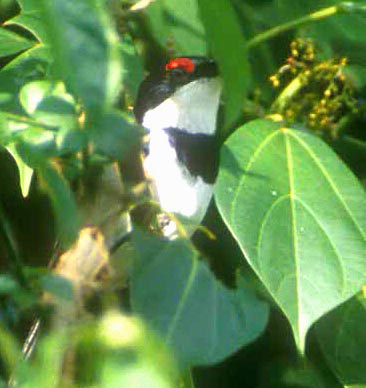 The
final group of birds in this family are the two genera of wattle-eyes.
Both genera have fleshy, colorful wattles above their eyes, but those in
genus Platysteira have long tails and forage at all levels in the canopy.
The most widespread is Brown-throated Wattle-eye (left),
named for the the throat color of the female, not the male (shown here).
Banded Wattle-eye P. laticincta is rare and little known, and confined
to the Bamenda Highlands of western Cameroon. The
final group of birds in this family are the two genera of wattle-eyes.
Both genera have fleshy, colorful wattles above their eyes, but those in
genus Platysteira have long tails and forage at all levels in the canopy.
The most widespread is Brown-throated Wattle-eye (left),
named for the the throat color of the female, not the male (shown here).
Banded Wattle-eye P. laticincta is rare and little known, and confined
to the Bamenda Highlands of western Cameroon.
The final group are six species of Dyaphorophyia wattle-eyes: White-spotted D. tonsa, Chestnut D. castanea, Red-cheeked D. blissetti, Jameson's D. jamesoni, Black-necked D. chalybea, and Yellow-bellied D. concreta. There is substantial debate about species limits in this group, with a number of authors lumping Red-cheeked and Jameson's, both little known birds, with Black-necked Wattle-eye. These little wattle-eyes are very small, almost tail-less, and impossibly
cute little birds. They forage quietly in the thick undergrowth of west
and central African rainforest. Most species have big eye-wattles surrounding
the dark eye in glowing shades of green or blue; many are patterned with
rich chestnut or yellow in addition to black and white. I was totally blown
away by the first two of these undergrowth wattle-eyes that I saw in Kakamega
Forest in w. Kenya way back in 1981 (Jameson's and Yellow-bellied). Of
Yellow-bellied I wrote in my notes this it was a "magnificent, neon-yellow,
silly little bird."
|
|||||
| Photos: Both the female and the male Pririt Batis Batis pririt were photographed at Spitzkoppe, n.w. Namibia, on 17 July 2005. The Cape Batis Batis capensis was in Kirstenbosch Gardens, Cape Town, South Africa, on 3 July 2005. The Rwenzori Batis B. diops was Ruhiza in Bwindi-Impenetrable Forest Park, Uganda, on 18 July 2002. The Pygmy Batis B. perkeo was in Samburu NP, Kenya, on 13 Nov 1981. The White-tailed Shrike Lanioturdus torquatus was at Spitzkoppe, n.w. Namibia, on 17 July 2005. The Brown-throated Wattle-eye Platysteira cyanea was in Bwindi-Impenetrable Forest Park, Uganda, on 19 July 2002 . All photos © 2005 Don Roberson; all rights reserved. | |||||
| Bibliographic note:
Family book: Rating This is a very attractive offering in the Princeton bird families series. Tony Harris wrote the text; Kim Franklin did the plates. It has the familiar layout of plates altogether in the front, with range maps and i.d. summary, and detailed species accounts in the back. It looks well researched and has a good bibliography. I very much enjoyed the full-page spreads, with black-and-white sketch, on each genus in the groups covered, that highlights the introduction. There is a lot of discussion of taxonomy but, unfortunately, the authors chose to follow the Sibley & Monroe (1990) approach of only two families: shrikes [Laniidae] and bush-shrikes [Malaconotidae]. All of the batises, wattle-eyes, helmet shrikes, and such things as flycatcher-shrikes, wood-shrikes, and philentomas, are thrown into the latter family. New research does not support this approach. As it turns out, the true shrikes are not the closest relatives to the rest of this set (e.g., Barker et al. 2004), so even the premise of this book proves false. Further, vangas (not included in this book) are closely related to the rest of the group. Indeed, it appears that the flycatcher-shrikes are vangas, and that helmet-shrikes are very closely related to vangas. The text also suffers from the author's use of the "Species Recognation Concept" as his definition for species; fortunately, in practice, in works rather like the tried-and-true "Biological Species Concept." Yet both in its language and in its reliance on DNA hybridization evidence (Sibley & Ahlquist 1990), this book has the unfortunate status of being out-of-date taxonomically much more quickly than would be anticipated. |
|||||
Other literature cited:
Barker, F.K., A. Cibois, P. Schikler, J. Feinstein, and J. Cracraft. 2004. Phylogeny and diversification of the largest avian radiation. Proc. Nat. Acad. Sci. 101: 11040-11045. |
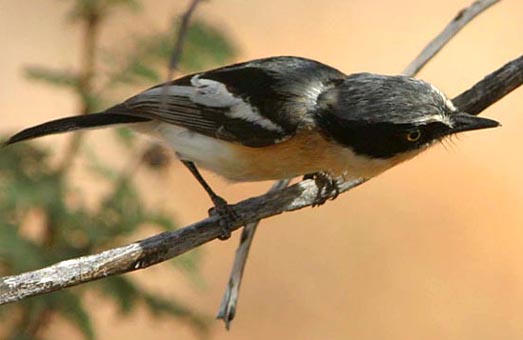

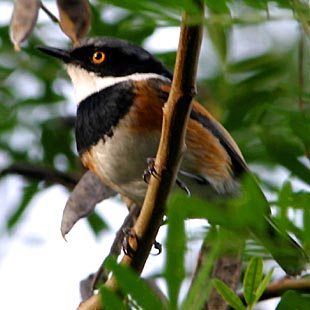
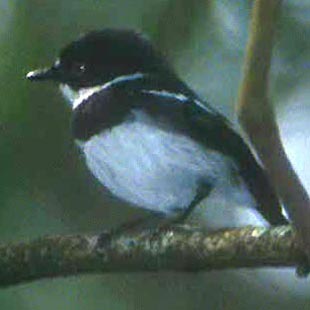
 Female
batises typically have a rusty or rufous breastband, as shown here by a
Pygmy
Batis (right), a very small species of arid thornscrub savanna
in northeast Africa from Kenya to Ethiopia.
Female
batises typically have a rusty or rufous breastband, as shown here by a
Pygmy
Batis (right), a very small species of arid thornscrub savanna
in northeast Africa from Kenya to Ethiopia.
